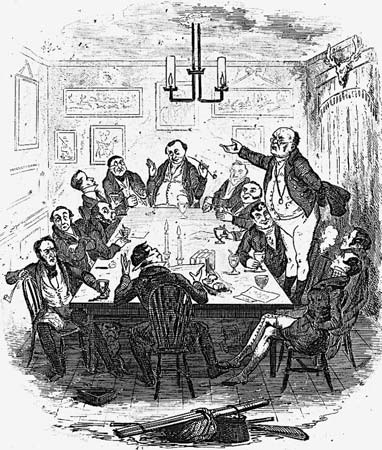
PERSONIFICATION

PERSONIFICATION
In this unit you will read and analyze poems by Emily Dickinson. She is very easy to read and understand. After you have read her work, you will review poetry terms and types.
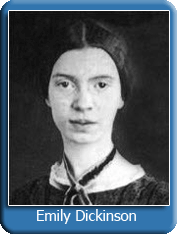 Emily Dickinson became famous for her poetry after her death. She wrote for herself, and as a result her verse was imperfect. She broke the rules if it sounded nice enough to her own ear. Some critics admit that her form is poor, but her thoughts were all very original. Mrs. T.W. Higgenson says of her, “In many cases these verses will seem to the reader like poetry torn up by the rocks, with rain and dew and earth still clinging to them, giving a freshness and a fragrance not otherwise to be conveyed.” Even though Dickinson was a messy writer, her work has a freshness of originality about it. It might not be properly polished, but it is still a satisfying read.
Emily Dickinson became famous for her poetry after her death. She wrote for herself, and as a result her verse was imperfect. She broke the rules if it sounded nice enough to her own ear. Some critics admit that her form is poor, but her thoughts were all very original. Mrs. T.W. Higgenson says of her, “In many cases these verses will seem to the reader like poetry torn up by the rocks, with rain and dew and earth still clinging to them, giving a freshness and a fragrance not otherwise to be conveyed.” Even though Dickinson was a messy writer, her work has a freshness of originality about it. It might not be properly polished, but it is still a satisfying read.
Emily Dickinson was born in Amherst, Massachusetts, in 1830. She was the second child born to Emily Norcross (1804-1882) and Edward Dickinson (1803-1874), a Yale graduate, successful lawyer, Treasurer for Amherst College and a United States Congressman. Her grandfather Samuel Fowler Dickinson (1775-1838) was a Dartmouth graduate, accomplished lawyer and one of the founders of Amherst College. She attended Mount Holyoke Female Seminary in South Hadley, but severe homesickness led her to return home after one year. Throughout her life, she seldom left her house and visitors were scarce.
The people with whom she did come in contact, however, had an enormous impact on her thoughts and poetry. She was particularly stirred by the Reverend Charles Wadsworth, whom she met on a trip to Philadelphia. He left for the West Coast shortly after a visit to her home in 1860, and some critics believe his departure gave rise to the heartsick flow of verse from Dickinson in the years that followed. While it is certain that he was an important figure in her life, it is not certain that this was in the capacity of romantic love—she called him "my closest earthly friend." Other possibilities for the unrequited love in Dickinson’s poems include Otis P. Lord, a Massachusetts Supreme Court Judge, and Samuel Bowles, editor of the Springfield Republican.
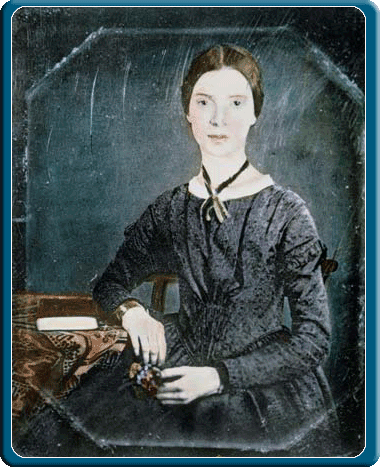
| “…for the true lovers of the prose or poetry of Emily Dickinson, explanation of her is as impertinent as unnecessary.” -Martha Dickinson Bianchi 1924 |
Because I could not stop for Death:
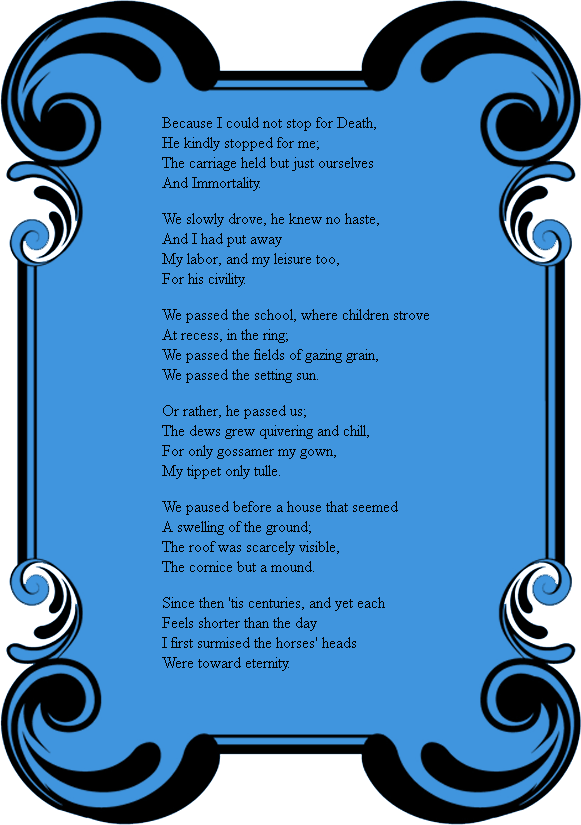
| Gossamer- very light, thin cloth |
| Tulle- a thin, fine netting used for veils, scarves, etc. |
| Tippet- covering for the shoulders |
Dickinson wrote several versions of this poem. Early editors dropped the fourth stanza, but it is included here. Do you think it strengthens the poem, or that it’s unnecessary?
The drive symbolizes the progression of Dickinson’s life. She goes through childhood, maturity (the “gazing grain” is ripe) and old age, the sun setting on her grave. In her coach she passes by children and grain, passing out of time and eternity. The setting sun casts a dark shadow over the light in the preceding stanzas. In the final stanza the speaker has moved into death; the language becomes more abstract instead of concrete. Death is a new journey, and the only experience the speaker has had is her own life. Does she seem ready for Death?
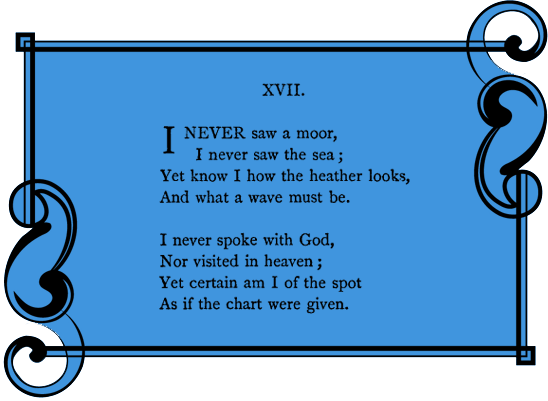
| Moor- open, overgrown land |
| Heather- a plant often seen on a moor |
| Billow- a large wave |
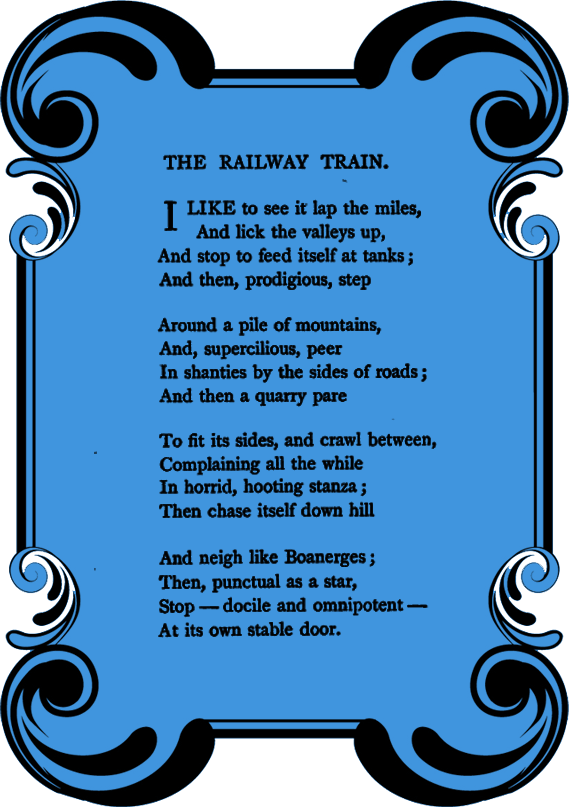
Boanerges- a fiery preacher, esp one with a powerful voice |
Emily Dickinson makes use of a figure of speech known as personification in this poem. Personification is the giving of human qualities to inanimate objects, or of abstract ideas to human traits and qualities, such as emotions, desires, sensations, physical gestures and speech. Some examples of personification are:
· The tulips were suffering from the intense heat.
· The teddy bear sat slumped on the bed, looking sadly at its feet.
Adopting a childlike wonder and enthusiasm, Dickinson plays with the metaphor of the train as an "iron horse." In her day, the similarities would have had a vividness and an immediacy that have been lost in ours (after all, how often do you use a horse for transportation?). The charm of the poem has not changed, however, even though in our day the phrase "iron horse" has become a cliché.
II. Review of General Terms
Consult the table to review concepts you have learned in this course so far. A few new terms have been added, so take note of them.
| Figurative Language: | Language meant to be interpreted imaginatively, not literally. |
| Sensory Language: | Appeals to the five senses – hearing, smell, touch, taste, sight – to help |
| Imagery: | When the writer describes something so well that the reader can almost |
| Simile: | A comparison of two unlike objects using the words “like” or “as”: |
| Metaphor: | A comparison of two unlike objects, speaking of one as if it were another: |
| Personification: | Giving qualities of human beings to things that are not human: The lawn mower contentedly chewed the grass. |
| Hyperbole: | Exaggeration or overstatement to get the point across: My dad will kill me if I fail English. |
| Allusion: | A reference to a person or event in history or previous literature. It is a means of suggesting more than you really say. The allusion calls your attention to a comparison of the thing or person in the poem with the allusion: He was a Romeo. |
| Symbol: | Person, place, or thing that has a meaning in itself but also stands for something else. |
| Irony: | Saying one thing and meaning another. |
| Rhyme: | Repetition of end sounds in words at the ends of lines or within a line of poetry: Dead, head, red, said. |
| Alliteration: | Repetition of beginning sounds in words appearing close together in a poem: Bold and brave. |
| Onomatopoeia: | The definition of a word is the sound of the word itself: Plop, whoosh. |
| Repetition/Form: | Parallel structure in a poem – of lines, stanzas, refrains, grammar |
| Stanza: | Word, phrase, line, or group of lines repeated regularly in a poem, usually at the end of verses. |
| Meter: | Pattern of stressed and unstressed syllables in a poem; rhythm. |
| Theme: | Insight into life provided by the poem. |
| Tone: | Attitude the writer takes toward the subject and audience. |
| Mood: | The feeling the poem creates in the reader. |
Types of Poetry |
|
| Narrative: | A poem that tells a story; includes a plot, characters, setting, etc. |
| Lyric: | A poem that expresses the poet’s thoughts and strong feelings about a |
| Free Verse: | Unrhymed poetry with irregular rhythms and varied line length. |
| Ballad: | A narrative poem that has a strong rhythm and rhyme; sometimes sung. |
| Haiku: | A seventeen syllable Japanese form; five syllables, seven syllables, five |
| Concrete: | A poem in which the shape of the poem on the page resembles the subject of the poem. |
